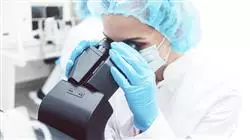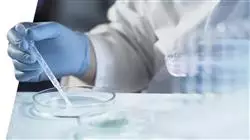University certificate
The world's largest faculty of veterinary medicine”
Introduction to the Program
Get a complete update on Mammalian Reproductive Biology and Technology in just 12 months"

Continued research in the field of Reproduction in Mammals has allowed the development of much more accurate techniques, understanding of genetics and tools to make precise changes in animal’s DNA. For this reason, it is necessary for veterinarians to be aware of the advances in this field, its benefits, as well as other disadvantages such as the outbreak of emerging diseases.
Faced with this reality, TECH has designed this Hybrid professional master’s degree in Biology and Technology of Reproduction in Mammals, which offers veterinarians an update through a syllabus developed by real experts in this field.
In this way, it will delve into the most rigorous and recent scientific literature in this field, as well as delve into the advances in reproductive biotechnology in males and females, sex selection in mammals or the latest advances in reproductive techniques or bioethics and the debates that arise in the face of new horizons.
Once this process is completed, graduates will enter a stay in a prestigious center that will allow them to perform a 100% practical update, under the mentoring of professionals with extensive experience in the field of Reproduction in Mammals. Undoubtedly, a unique opportunity to apply the concepts addressed, in a first level clinical space and with real patients.
With this program you will be up to date in the application of the CRISPR/CAS technique in animal models"
This Hybrid professional master’s degree in Biology and Technology of Reproduction in Mammals contains the most complete and up-to-date scientific program on the market. The most important features include:
- Development of more than 100 clinical cases presented by veterinary experts in Human Reproduction
- The graphic, schematic, and practical contents with which they are created, provide scientific and practical information on the disciplines that are essential for professional practice
- Patient assessment and monitoring, the latest international recommendations on embryo transfer, artificial insemination, or creation of embryo banks
- Integral action plans for birth and lactation techniques
- Presentation of practical workshops on procedures diagnosis, and treatment techniques
- Algorithm-based interactive learning system for decision-making in the presented clinical situations
- Practical clinical guides on approaching different pathologies
- With a special emphasis on evidence-based medicine and research methodologies in Reproduction in Mammals
- All of this will be complemented by theoretical lessons, questions to the expert, debate forums on controversial topics, and individual reflection assignments
- Content that is available from any fixed or portable device with an Internet connection
- Furthermore, you will be able to carry out a clinical internship in one of the best veterinary centers
Take an intensive 3-week internship in a prestigious center and update your technical skills for embryo transfer"
In this proposal for a Professional Master's Degree, of a professionalizing nature and Hybrid learning modality, the program is aimed at updating veterinary professionals who perform their functions in centers specialized in Reproduction in Mammals, and who require a high level of qualification. The content is based on the latest scientific evidence and is organized in a didactic way to integrate theoretical knowledge into nursing practice. The theoretical-practical elements allow professionals to update their knowledge and help them to make the right decisions in patient care.
Thanks to the multimedia content, developed with the latest educational technology, veterinary professionals will benefit from situated and contextual learning, i.e., a simulated environment that will provide immersive learning programmed to train in real situations. This program is designed around Problem-Based Learning, whereby the physician must try to solve the different professional practice situations that arise during the course. For this purpose, the students will be assisted by an innovative interactive video system created by renowned and experienced experts.
This Hybrid professional master’s degree will allow you to update your skills in birth and lactation techniques in mammals"

Face future challenges in reproduction in mammals with greater guarantees thanks to TECH"
Why study at TECH?
TECH is the world’s largest online university. With an impressive catalog of more than 14,000 university programs available in 11 languages, it is positioned as a leader in employability, with a 99% job placement rate. In addition, it relies on an enormous faculty of more than 6,000 professors of the highest international renown.

Study at the world's largest online university and guarantee your professional success. The future starts at TECH”
The world’s best online university according to FORBES
The prestigious Forbes magazine, specialized in business and finance, has highlighted TECH as “the world's best online university” This is what they have recently stated in an article in their digital edition in which they echo the success story of this institution, “thanks to the academic offer it provides, the selection of its teaching staff, and an innovative learning method aimed at educating the professionals of the future”
A revolutionary study method, a cutting-edge faculty and a practical focus: the key to TECH's success.
The most complete study plans on the university scene
TECH offers the most complete study plans on the university scene, with syllabuses that cover fundamental concepts and, at the same time, the main scientific advances in their specific scientific areas. In addition, these programs are continuously being updated to guarantee students the academic vanguard and the most in-demand professional skills. In this way, the university's qualifications provide its graduates with a significant advantage to propel their careers to success.
TECH offers the most comprehensive and intensive study plans on the current university scene.
A world-class teaching staff
TECH's teaching staff is made up of more than 6,000 professors with the highest international recognition. Professors, researchers and top executives of multinational companies, including Isaiah Covington, performance coach of the Boston Celtics; Magda Romanska, principal investigator at Harvard MetaLAB; Ignacio Wistumba, chairman of the department of translational molecular pathology at MD Anderson Cancer Center; and D.W. Pine, creative director of TIME magazine, among others.
Internationally renowned experts, specialized in different branches of Health, Technology, Communication and Business, form part of the TECH faculty.
A unique learning method
TECH is the first university to use Relearning in all its programs. It is the best online learning methodology, accredited with international teaching quality certifications, provided by prestigious educational agencies. In addition, this disruptive educational model is complemented with the “Case Method”, thereby setting up a unique online teaching strategy. Innovative teaching resources are also implemented, including detailed videos, infographics and interactive summaries.
TECH combines Relearning and the Case Method in all its university programs to guarantee excellent theoretical and practical learning, studying whenever and wherever you want.
The world's largest online university
TECH is the world’s largest online university. We are the largest educational institution, with the best and widest online educational catalog, one hundred percent online and covering the vast majority of areas of knowledge. We offer a large selection of our own degrees and accredited online undergraduate and postgraduate degrees. In total, more than 14,000 university degrees, in eleven different languages, make us the largest educational largest in the world.
TECH has the world's most extensive catalog of academic and official programs, available in more than 11 languages.
Google Premier Partner
The American technology giant has awarded TECH the Google Google Premier Partner badge. This award, which is only available to 3% of the world's companies, highlights the efficient, flexible and tailored experience that this university provides to students. The recognition as a Google Premier Partner not only accredits the maximum rigor, performance and investment in TECH's digital infrastructures, but also places this university as one of the world's leading technology companies.
Google has positioned TECH in the top 3% of the world's most important technology companies by awarding it its Google Premier Partner badge.
The official online university of the NBA
TECH is the official online university of the NBA. Thanks to our agreement with the biggest league in basketball, we offer our students exclusive university programs, as well as a wide variety of educational resources focused on the business of the league and other areas of the sports industry. Each program is made up of a uniquely designed syllabus and features exceptional guest hosts: professionals with a distinguished sports background who will offer their expertise on the most relevant topics.
TECH has been selected by the NBA, the world's top basketball league, as its official online university.
The top-rated university by its students
Students have positioned TECH as the world's top-rated university on the main review websites, with a highest rating of 4.9 out of 5, obtained from more than 1,000 reviews. These results consolidate TECH as the benchmark university institution at an international level, reflecting the excellence and positive impact of its educational model.” reflecting the excellence and positive impact of its educational model.”
TECH is the world’s top-rated university by its students.
Leaders in employability
TECH has managed to become the leading university in employability. 99% of its students obtain jobs in the academic field they have studied, within one year of completing any of the university's programs. A similar number achieve immediate career enhancement. All this thanks to a study methodology that bases its effectiveness on the acquisition of practical skills, which are absolutely necessary for professional development.
99% of TECH graduates find a job within a year of completing their studies.
Hybrid Professional Master's Degree in Biology and Technology of Reproduction of Mammals
At TECH Global University, we present our innovative Hybrid Professional Master's Degree in Biology and Technology of Reproduction of Mammals, a unique opportunity to enter the fascinating world of animal reproduction and acquire specialized knowledge in this constantly evolving field. This program combines the flexibility of the online modality with the advantages of face-to-face interaction, providing you with a comprehensive educational experience. The biology and technology of mammalian reproduction play a fundamental role in species conservation, genetic improvement, food production and the advancement of veterinary medicine. With our Hybrid Professional Master's Degree, you will have the opportunity to acquire up-to-date knowledge of reproductive processes, from fertilization to embryonic development and gestation, as well as become familiar with assisted reproductive techniques and genetic manipulation.
Enroll in this program and get quality in your education
Our team of professors, made up of leading researchers and experts in the field of biology and animal reproduction, will guide you through the program, providing you with the theoretical and practical knowledge necessary to understand the biological processes involved in mammalian reproduction. Through our state-of-the-art virtual platform, you will have access to interactive materials, real-time online classes and multimedia learning resources. Upon completion of the Hybrid Professional Master's Degree in Biology and Technology of Reproduction of Mammals, you will have acquired the skills necessary to meet the challenges and opportunities in the field of animal reproduction. You will become a highly qualified professional and will be prepared to provide innovative solutions in research, species conservation and genetic improvement. Don't miss the opportunity to develop your career in the fascinating area of mammalian biology and reproduction! Join TECH Global University and acquire the knowledge and skills that will open the doors to a promising future in this exciting field.







